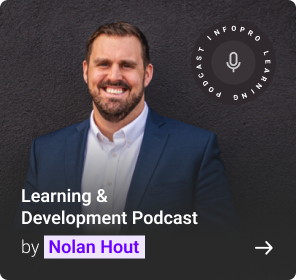Change management is the process of identifying, planning, and implementing changes in an organization to improve overall performance and meet the evolving needs of the stakeholders. The goal of change management is to minimize disruptions and negative impacts while maximizing the benefits of the changes being made. Effective change management requires strong leadership, clear communication, and a well-defined plan to ensure that the changes are implemented successfully. A study by the Boston Consulting Group found that companies that excel at change management have a 6% higher productivity rate and are 2.5 times more likely to be successful in their market.
Listen to Mindy Stone-Szabo, Vice President of Learning and Development and Organizational Effectiveness at Papa Murphy’s International, speak with Nolan Hout, Senior Vice President at Infopro Learning, about her role as a change management advocate, her experiences leading change, the significance of having a positive attitude towards change, and more.
Listen to the podcast to learn more:
Expert profile:

Mindy Stone-Szabo is a highly experienced learning and development professional with over 25 years of experience. She currently holds the position of Vice President of Papa Murphy’s International Learning and Development/Organizational Effectiveness and has been with the company for over six years. Mindy is responsible for talent development for both corporate and franchise employees. She led her team to win two Association of Talent Development BEST Awards in 2019 and 2021 for outstanding career path curriculum and employee development programs. Additionally, Mindy is a Certified Professional in Talent Development (CPTD) and a certified Hogan Leadership Coach.

Nolan Hout is the Senior Vice President at Infopro Learning. He has over a decade of experience in the L&D industry, helping global organizations unlock the potential of their workforce. Nolan is results-driven, investing most of his time in finding ways to identify and improve the performance of learning programs through the lens of return on investment. He is passionate about networking with people in the learning and training community. He is also an avid outdoorsman and fly fisherman, spending most of his free time on rivers across the Pacific Northwest.
An excerpt of the discussion follows:
Nolan:
Welcome to the Learning and Development podcast, sponsored by Infopro Learning.
I’m your host, Nolan Hout, and today we’ll be joined by Mindy Stone-Szabo, who is the vice president of learning and development and organizational effectiveness at one of my family’s favorite pizza places, Papa Murphy’s.
Mindy rose like a rocket ship at Papa Murphy’s; she went from a career in public education to vice president in under eight years. Today we’re going to talk with Mindy briefly about how she transitioned from that role as a teacher to corporate life. But we’ll spend the majority of the time talking about Change Management.
Hello, Mindy. Welcome to the podcast.
Mindy:
Hi, Nolan. Thank you so much for having me.
Nolan:
I will jump right into it here.
One of the most interesting things that I’ve always found in talking to leaders like yourself is the story of how you got there. This is one of the most fascinating things for all of our listeners here on the podcast, whether they are in leadership positions themselves or are aspiring to be in leadership positions.
If you could give me a brief overview of where you started in your career and how that journey led you to where you are today?
Mindy:
I love that you start with that because everyone does have a unique story of getting there, and from mine, that’s no different. It’s a very unorthodox approach to getting to where I am now.
About 25 years ago, when I started as an 8th-grade English teacher, I was only certified to teach K6, and they hired me for 8th grade. That started my whole career of getting into things that I might not have been ready for, but I did it anyway because it was exciting, and you wing it and go for it; you take the risk and you hope it works out. And for the most part, it does.
That then led me eight years later to teach 8th grade English; they then took me to high school, and I spent another 8–9 years teaching at the high school English level and doing public speaking and professional development at the district level. That was back in Denver.
I then decided to move past my teaching career. My family and I had come out to visit the Pacific Northwest a few times. I looked for jobs out here. I got the job with Papa Murphy’s seven years ago as a senior manager of training.
There was no real structure to the learning and development team. It didn’t exist. There was one trainer in operations. And so, I was able to build my program very independently.
I was able to build my team over the years and build two curriculums, one for the corporate side and one for the franchise side, and bring in onboarding programs and emerging leader programs. It’s been really rewarding. Seven years later, here I am.
Nolan:
We see a tendency for education to continue in corporate training. But what was that like? What was it like for you when you came into the corporate world after spending so much time in the public sector? Was it a relief?
Mindy:
It’s just a different shade of red tape. But I think the strangest things shocked me. Number one, I could take more than a 20-minute lunch.
Any teacher out there knows you’re scarfing your food if you even get to scarf your food before you go back. And when I first took the corporate job and somebody showed me the office supply room, I was like, “OK, so do I need to check out something when I take a pen?”
And they’re like, “No, you can take whatever you want, whenever you need it.” And I was like, “Wait, what?”
I don’t have to check out the paper because that’s how it has been. You have to enjoy socializing with your firstborn in real life. So that was a really strange adjustment for me: I can be myself and people treat me like an adult and not the kids I teach.
Mindy and Nolan delved deeper into the different situations encountered in both school and corporate settings, through which Mindy realized the reasons for her current relatively stress-free existence.
Nolan:
When we look at change management, did you always have a kind of knack for, “When something is changing, I need to document it, I need to process it, I need to understand all the components,” or was it more of something that, now that you have a senior leadership position, has become like a mission-critical item for you?
Mindy:
The second of these has become essential for me. I think that the way that I grew up, change was just a constant, and change was embraced. The change was part of the world that I lived in, and I loved it and still do. As a result, I’ve never been a skeptic of change. I’ve always kind of worked through it and found ways to navigate others through it and help guide them. But right now, in my position, it’s more about building a structure where people feel safe and confident that they can do that, that they can make that transformation happen, and not fear repercussions, failure, or all of the other things that we fear. And that holds us back from making a change.
Nolan expanded on his perspective and shared how change has been a constant presence throughout his life, starting from his childhood. Mindy echoed this sentiment by highlighting the emotional challenges and resistance to change that often accompany any significant change.
Nolan:
Retail and restaurants had enormous change management during the pandemic. What was it like to help your organization navigate that?
We were fortunate at Papa Murphy’s because we didn’t have to close our stores like so many other quick-service restaurant brands did. We have a grocery business model, and because we don’t cook or bake anything in-store, we were able to stay open during the pandemic.
Now on the corporate side of things, when we went remote with everybody else, some people were like, “How do we do this?” I thought for sure I would suffer. I’m pretty extroverted. I like to socialize. I like to be around people. I get my energy from other people. And I thought for sure I was going to dig a hole and just die there. We got our offices and our homes, and we got them all set up within that first week or two.
We either went straight to high or straight to virtual everything. We did a lot of professional development courses at all of our meetings. We did virtual happy hours right out of the gate. We didn’t waste any time, and those who wanted to join could join. Those people who weren’t quite ready didn’t have to join right away. It also made the transition into a hybrid remote workforce feel natural.
We continue to adopt. We made that transition quickly without bringing a lot of people on board with us, which is the opposite of what we usually like to do with change management. We need to do it. We’re right there in the sense that we couldn’t waste time.
Nolan:
Have you found any kind of rule of thumb for change management, or it’s just your instincts when you see this as something that begs for forgiveness versus these other ones?
Mindy:
I think it’s a blend of both. Sometimes you do go on your instinct; you know the people well enough who are going to be involved in it, and the background that’s led up to it. And so, you’ve got a good gut feeling on, “OK, we’re going to need to manage this change tightly, or we can pretty much navigate through this together as we just go with it right out of the gate.”
Would I like to examine it from a structural standpoint and focus on it? What is it we’re trying to do? Why are we changing? That’s the core question that comes up all the time: Why are we doing this? Who’s going to resist? Who’s going to push back? When we answer that why are we changing? We don’t need to change. We’ve always done it this way. It’s not going to work. We’ve tried it before.
Get ahead of those questions and talk to those people who you think will probably be the barriers to moving forward if you look at the whole Prosci ADKAR model is that awareness and desire of who will be your barriers, who will not have that desire to change when you explain why we’re doing this correctly, and then you’ll need to build in a tighter structure.
And you’re going to need to stop and get the group together and talk through it. What are the resistance factors here? What is it that we’re changing that you fear? What is it that we’re changing that you think will impact you negatively? What is it that you think will impact your team? How will we navigate that? And when you ask those questions and drive home those conversations, rather than ignoring them by assuming people will be there with us and they’ll just get over it, you’ll be surprised. Because we want to get things done so quickly. We’re doing ourselves a disservice if we don’t stop and have those conversations with the right people.
The podcast continued to delve into the impact of change management on employees and the workforce, as well as exploring various other intriguing topics. Some of the other topics covered during the podcast included:
- When you go about building, not everything has a very strict change management plan. Maybe some companies do, and maybe some companies don’t. What are some of the tools that you use, if any, that are repeatable or scalable that you found to help you along the way through change management, Gantt chart? Raci matrix?
- What advice would you give to those who are trying to get that budget to help somebody whose sole job is change management, the project management person?
- Is there any lesson you learned that you would like to share with our audience, either a lesson or a surprise result or outcome? Maybe a positive one or a negative one anything that surprised you that you feel might help others who are on this journey.




